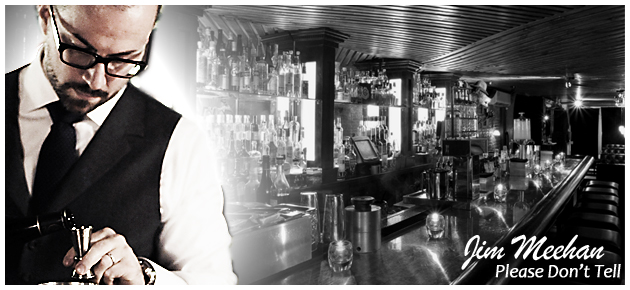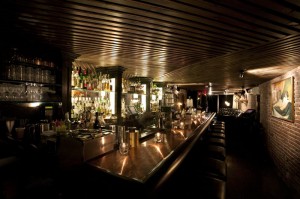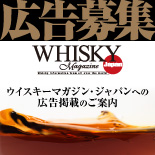TIBS2013 Bartender Interview / Mr. Jim Meehan
――Jim, We’re really looking forward to welcoming you to the Tokyo International BarShow(TIBS) this April. What are your thoughts- is this your first time to Japan, what are you expecting?
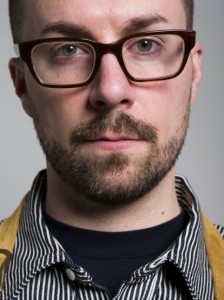 Jim Meehan I can’t wait! This is actually going to be my third trip to Tokyo in the last six months. My first visit was in October, when I visited Yamazaki and Hakushu on behalf of Suntory. It was a wondrous introduction to Japanese whisky, culture and much of what the cocktail scene has to offer. I finally visited my dear friend Ueno at Bar High Five, was served by Kazuo Ueda at Tender Bar, and enjoyed my time at Bar Rocking Chair in Kyoto among many other places.
Jim Meehan I can’t wait! This is actually going to be my third trip to Tokyo in the last six months. My first visit was in October, when I visited Yamazaki and Hakushu on behalf of Suntory. It was a wondrous introduction to Japanese whisky, culture and much of what the cocktail scene has to offer. I finally visited my dear friend Ueno at Bar High Five, was served by Kazuo Ueda at Tender Bar, and enjoyed my time at Bar Rocking Chair in Kyoto among many other places.
I’m headed back in a month to serve drinks in the Park Hyatt’s New York Bar with two members of my staff from March 19th-22nd. We’ve created a dozen new recipes to introduce at the hotel. I’m bringing my wife and newborn daughter to experience some of what I did in October. We’re looking forward to visiting the fish market before it closes and another big shopping trip at Sokichi.
When I come back in April for the TIBS, I’m hoping to meet more Japanese bartenders, visit more bars, and there’s a good chance I’ll be picking up a few shifts at a friend’s bar: more details to come! I’ve had the pleasure of travelling with Peter Dorelli and his wife before, and they’re lovely. I will be doing my best to tag along with him: no one lights up a room with his smile and laughter like Peter.
――Intriguing name – Bar Please Don’t Tell… well please do tell. What is the bar about and what makes it different?
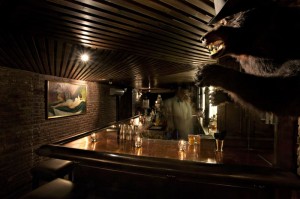 Jim PDT stands for Please Don’t Tell, but we’re known to most as PDT. Our bar is unique, as you must enter it via a vintage phone booth in Crif Dogs, a popular hot dog stand in Manhattan’s East Village. We are best known for popularizing the modern speakeasy cocktail bar concept, but ultimately, I hope we’re remembered for our creative cocktails, gracious hospitality, and comfortable environment. When we opened, many of the world’s best bars were quite formal, and it was our goal to continue to raise the bar without making the room feel exclusive. In addition to the cocktails, I’m proud of our short list of local wines and beers, and of the unique hot dog menu featuring some of downtown Manhattan’s most celebrated chefs. I’d like to think there’s a little something for all our guests at PDT. As for the name, we figured our guests would talk about the bar if we asked them not to, and they have: you can’t tell New Yorkers what to do !
Jim PDT stands for Please Don’t Tell, but we’re known to most as PDT. Our bar is unique, as you must enter it via a vintage phone booth in Crif Dogs, a popular hot dog stand in Manhattan’s East Village. We are best known for popularizing the modern speakeasy cocktail bar concept, but ultimately, I hope we’re remembered for our creative cocktails, gracious hospitality, and comfortable environment. When we opened, many of the world’s best bars were quite formal, and it was our goal to continue to raise the bar without making the room feel exclusive. In addition to the cocktails, I’m proud of our short list of local wines and beers, and of the unique hot dog menu featuring some of downtown Manhattan’s most celebrated chefs. I’d like to think there’s a little something for all our guests at PDT. As for the name, we figured our guests would talk about the bar if we asked them not to, and they have: you can’t tell New Yorkers what to do !
――When did you first become aware of Japanese bartending and how have your impressions changed since that first encounter?
Jim I visited Angel’s Share in 2000, two years before I moved to Manhattan. Unfortunately, I sat at a table away from the bar, so I didn’t get to watch the bartenders. Years later, my friend Eben Freeman generated a great deal of interest in Japanese bartending when he started using the Japanese hard shake method at Tailor around 2005. Around this time, I befriended Shin Ikeda at B Flat Bar, who previously managed Angel’s Share, who showed me many of the techniques he learned in Japan. Greg Boehm of Cocktail Kingdom translated Cocktail Technique by Kazua Ueda in 2010, which helped spread the philosophy of one of Japan’s most famous masters. Over the years, I’ve spent time with Hidetsugo Ueno on my travels, who’s my dearest friend in Tokyo. My impression of Japanese bartending remains the same today as it was when I first encountered it: refined, traditional, precise, and hospitable.
――How did you first get into the bartending business and how do you think your style and approach have changed since the early days?
Jim I took a job at a bar called State Street Brats in Madison, Wisconsin in 1995 to help pay for college. It’s still there; been open since the 1950’s, and it couldn’t be any different than PDT. With that said, what I learned there: to work hard, take care of my coworkers and customers, and respect the difference between hosting the party and attending it, still holds true today. Just like fashion, the wine, beer and spirits we sell change as popular tastes shift. What remains the same is the commitment to take care of the customers and provide them with good products. I suppose the biggest change has been in me: I started as an 18 year old college kid, and now I’m a 36-year-old father and businessman. When I was 22 years old, I decided to commit myself to the bar business after finishing my studies, and I’m still in it. I love it.
――Which spirit category particularly excites you at the moment as a base for your cocktails?
Jim They all excite me! With that said, and given the context, I’ve grown fond of Japanese Whisky, Sake and Shochu recently, and am trying to learn more about traditional Japanese food and drink. I’m particularly fond of Hakushu and Yamazaki, and Nikka’s whiskies have just begun to be distributed in the U.S. Westerners are very interested in Japanese food & drink: open up a Michelin guide!
――Where do you get your inspiration for new cocktail recipes? Do you find a key ingredient that you try to build something around or do you start with a final flavour concept and work back to find the ingredients that are going to get you there?
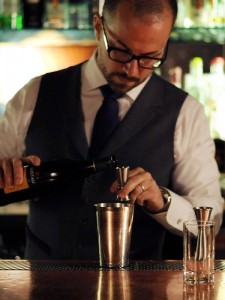 Jim I get ideas for cocktails when I’m at dinner in a restaurant, in a grocery store, at the farmer’s market: even when I’m taking a shower. I’m always thinking about flavors, ingredients, new products and how cocktails tell a story. I plan on talking about my process in my seminar, so I don’t want to spoil it, but the vast majority of my ideas are grounded in classic cocktail recipes, which I use as the framework to create new combinations. The best way to create something “new” is to use ingredients that would never be thought of for cocktails, or that were just released. Once the pieces are in place, I test the recipe over and over till all the ingredients are balanced. The final question is “Is it delicious?” If the answer is yes, it goes on a menu.
Jim I get ideas for cocktails when I’m at dinner in a restaurant, in a grocery store, at the farmer’s market: even when I’m taking a shower. I’m always thinking about flavors, ingredients, new products and how cocktails tell a story. I plan on talking about my process in my seminar, so I don’t want to spoil it, but the vast majority of my ideas are grounded in classic cocktail recipes, which I use as the framework to create new combinations. The best way to create something “new” is to use ingredients that would never be thought of for cocktails, or that were just released. Once the pieces are in place, I test the recipe over and over till all the ingredients are balanced. The final question is “Is it delicious?” If the answer is yes, it goes on a menu.
――What do you think the ‘big thing’ will be in bartending in 2013?
Jim As each cocktail capitol embraces its local spirits, wine, beer, produce and culinary traditions, I think we’ll see less global trends and more specialization in each market. As emerging markets for mixology open in Russia, India and China, I think we’ll see huge supply and demand issues begin to pop up in the near future. In America we see it with our Bourbons and Ryes, in Mexico you see it when there have been agave shortages to make Tequila, and we’re destined to see it in Scotland as Scotch Whisky becomes more popular. Craft beer and cult wine producers face these shortages today. Ultimately, I think we’ll see many bartenders embrace the situation by focusing on what’s available, instead of fretting over shortages. In the meantime, the next “big thing” will remain linked to the quality of communication technology. The Internet has changed our world; bringing it closer together through words, pictures and videos.
――If you were only allowed to drink one type of cocktail for the rest of your life, what would it be?
Jim I suppose it would have to be the Jimmie Roosevelt from Charles H. Baker’s The Gentleman’s Companion. It’s a Champagne Cocktail with Cognac and Green Chartreuse. It evolves on the palate as the sugar cube dissolves and the ice cubes melt, and it’s delicious. If I were to be limited, I couldn’t pick a better combination of ingredients to be stuck with!
――Tell us a little about the NY bar scene at the moment- is it innovation-led or are classic cocktails ruling the roost?
Jim We have a little bit of everything right now. I’d say bars such as Booker & Dax are pushing the boundaries technologically. The newly opened Dead Rabbit and Experimental Cocktail Club give our city an international influence. Milk & Honey remains focused on the classics. Restaurant bars such as Aska in Brooklyn are taking a culinary approach, and more venerable bars such as Peg Club are maintaining the standards of service and hospitality. With dynamic new hotel bars such as the bar at Nomad, we have a lot going on. In the past, two are three new cocktail bars would have been a lot. For the last couple years, we’ve had between 5-6 great new bars open and this year, over 10. We’re blessed with diversity in both Manhattan and Brooklyn.
―― Aside from the States and Japan, which other countries do you see as being as the forefront of the cocktail world at the moment and why?
Jim To me, London is the cocktail capitol of the world. It’s one of the most diverse cities culturally, and with so many global businesses headquartered there, there’s plenty of money being spent to keep the party going. I’ve enjoyed great drinks in Germany, Denmark, Australia, France and Sweden, but the U.K. remains the most compelling for me.
――Jim, many thanks for your time. See you at TIBS!
カテゴリ: Archive


